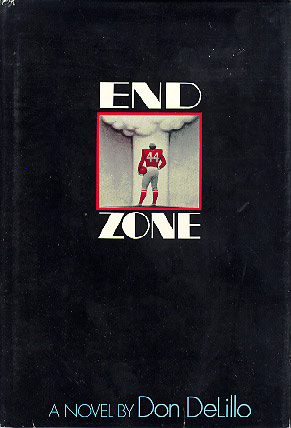

This page lists the known reviews of Don DeLillo's 1972 novel, End Zone.
General Critical Reaction:
Many critics felt that this was a real breakthrough for DeLillo.
A much more focused and original novel than Americana,
the New York Times Book Review featured End Zone on the
front page, and was very enthusiastic. Time magazine however
later called the book "much overpraised."
Antioch Review: Spring 1972 (V32/#1&2) - very short review of End Zone.
Most athletes aren't as smart as those in End Zone and many are funnier. The jokes are stale, 1960s "existential" humor (the end zone by nature has No Exit), and there is something vaguely incongrous about the plethora of profoundly philosophical jocks who inhabit this novel (Howard Cosell, watch out!). Indeed, it is, finally, a book for intellectuals, but not for sports fans of any stripe.
In his second novel, DeLillo sustains the fluency of his first yet has lost momentum. As if the momentum he picked up in Americana had propelled him onto the football field but had not quite carried him across the goal line. The book closes like a play on which the curtain has failed to descend. Not because the curtain wasn't ready but because the players had been in too much of a hurry to get offstage.
New Yorker: May 6, 1972 - briefly noted, unsigned review of End Zone.
A humorous pastiche of jargon, clichés, slang, wisecracks, and strange flights of lyricism, all having to do with several months spent by a football player named Gary Harkness at an obscure college in west Texas. The book gives us football in its raw form, without a sportswriter's gloss.
New York Review of Books: June 29, 1972 - review of End Zone by Roger Sale.
If I read DeLillo rightly, he is saying that the immensely organizing, expressive, and suffocating jargons of our life give our existence focus, and help keep from us our isolation, our confusions, and our penchant for violence. Harkenss tells his ROTC professor that the phrase "thirty million people dead" does not do justice to his sense of nuclear holocaust, by which he means he wants a language more vivid and fascinating, one that can satisfy his need to be violent and terrified but that is still language and therefore protective, satisfying. Or, Myna Corbett has two friends, sisters, who appear now and then. One is "into carrots" and the other is "into miracles," and one winces, knowing that if they were not "into" somthing they would by (sic) nothing at all. DeLillo is being satiric here, but his target is not jargon but its users.
New York Times: March 22, 1972 - "A Touchdown for Don DeLillo" review of End Zone by Christopher Lehmann-Haupt.
All of which may explain what Mr. DeLillo is up to but leaves out everything that makes his novel wonderful - the craft with which he builds the scenes that make the foregoing lines seem funny; the grace and humor of his own narrative voice; the football fantasies that would make even Alex Karras envious; the football game told in pure jargonese that makes up the exciting centerpiece of the novel; a pick-up game played in the snow that ought to be placed all in textbooks on creative writing to demonstrate the art of building a scene - simply everything.
New York Times Book Review: April 9, 1972 - page one review of End Zone by Thomas R. Edwards.
This isn't just a "football novel," that is. Gary's involvement with the sport is a version of his horrified fascination with the vocabulary, theory and technology of modern war à la Herman Kahn. From AFROTC Major Staley, a three-letter man and a veteran of the Nagasaki raid, he learns the larger play-book, whose rich and only too meaningful gibberish - "perimeter acquisition radar, unauthorized explosions, slow-motion countercity war, super-ready status, collateral destruction" - reverberates in DeLillo's lovely parodies of the argot of technical football: "monsoon sweep, string-in-left, ready right, cradle out, drill-9 shiver, ends chuff." Or (as it were), Plutonium two thirty-nine, Cerium one forty four, Strontium ninety, Hup!
Time: April 17, 1972 - briefly noted, unsigned review of End Zone.
It isn't so much that these characters are bigger than life. DeLillo's overly schematic vision of life is too small for them.
Times Literary Supplement (London): September 14, 1973 - "Beefcake blues" review of End Zone.
It is significant, perhaps, that the book is most successsful and most enjoyable when the narrative is forced to be straight about football and characters alike; when, for example, a wry humour is extracted from the team coach's exchanges with the players, or from the hairy-chested homilies delivered at the end of a training session.
Washington Post Book World: April 16, 1972 - "A kick in the head" review of End Zone by S.K. Oberbeck.
The combining element is power; enormous, explosive power, whether pooled on a football field or in missile silos. Behind their automaton-like facades, DeLillo's players are devoured in a chillingly funny way by utterly cosmic preoccupation, as if they were generals or cabinet members or corporation heads. Angst and anomie dog their tracks as they switch in and out of character, mouthing the mysterious, half-childish incantations of the playing field.